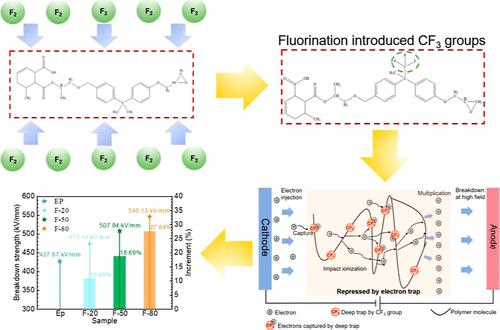当前位置:
X-MOL 学术
›
ACS Appl. Polym. Mater.
›
论文详情
Our official English website, www.x-mol.net, welcomes your
feedback! (Note: you will need to create a separate account there.)
Constructing Fluorine Hybrid Epoxy Polymers with Excellent Breakdown Strength by Surface Fluorination
ACS Applied Polymer Materials ( IF 4.4 ) Pub Date : 2023-11-13 , DOI: 10.1021/acsapm.3c02011 Mingru Li 1 , Kai Shang 1 , Jiuhui Zhao 1 , Liuhao Jiang 1 , Jingpeng Sun 2 , Xin Wang 2 , Huan Niu 1 , Yang Feng 1 , Zhenlian An 2 , Shengtao Li 1
ACS Applied Polymer Materials ( IF 4.4 ) Pub Date : 2023-11-13 , DOI: 10.1021/acsapm.3c02011 Mingru Li 1 , Kai Shang 1 , Jiuhui Zhao 1 , Liuhao Jiang 1 , Jingpeng Sun 2 , Xin Wang 2 , Huan Niu 1 , Yang Feng 1 , Zhenlian An 2 , Shengtao Li 1
Affiliation

|
The inferior breakdown strength of epoxy resin (EP) is one of the greatest barriers which restricts the evolution of advanced electrical equipment and electronic devices. It had been reported that constructing fluorine hybrid polymers was successful in improving the breakdown strength of organic dielectrics. Therefore, in this study, we constructed fluorine hybrid EP with a satisfactory breakdown strength by surface fluorination. It was found experimentally that the fluorination introduced CFn groups into EP molecules and contributed to a greater trap level and breakdown strength. After fluorination at 80 °C for 1 h, the CF3 fraction in fluorinated EP was 14.31%, and the breakdown strength was increased by 27.64%, from 427.87 to 546.13 kV/mm. The density functional theory simulations showed that the CF3 groups increased the maximum of positive Mulliken charge (MPMC) of EP molecules. Compared to pristine EP, after introducing CF3 groups, the MPMC was increased from 0.655 to 0.973 eV, which was instrumental in constructing electron traps with a greater level. Thus, the charge transport process in fluorinated EP was repressed and contributed to the superior breakdown strength. This study proposed a strategy to exploit EP polymers with greater breakdown strength and could promote the development of advanced insulation dielectrics for power devices.
中文翻译:

通过表面氟化构建具有优异击穿强度的氟杂化环氧聚合物
环氧树脂(EP)较低的击穿强度是制约先进电气设备和电子器件发展的最大障碍之一。据报道,构建氟杂化聚合物成功地提高了有机电介质的击穿强度。因此,在本研究中,我们通过表面氟化构建了具有令人满意的击穿强度的氟杂化EP。实验发现,氟化将 CF n基团引入 EP 分子中,有助于提高陷阱能级和击穿强度。80 ℃氟化1 h后,氟化EP中CF 3含量为14.31%,击穿强度提高了27.64%,从427.87 kV/mm增加到546.13 kV/mm。密度泛函理论模拟表明CF 3基团增加了EP分子的最大正Mulliken电荷(MPMC)。与原始EP相比,引入CF 3基团后,MPMC从0.655增加到0.973 eV,这有助于构建更高水平的电子陷阱。因此,氟化EP中的电荷传输过程受到抑制,并有助于提高击穿强度。这项研究提出了一种开发具有更高击穿强度的 EP 聚合物的策略,可以促进功率器件先进绝缘电介质的开发。
更新日期:2023-11-13
中文翻译:

通过表面氟化构建具有优异击穿强度的氟杂化环氧聚合物
环氧树脂(EP)较低的击穿强度是制约先进电气设备和电子器件发展的最大障碍之一。据报道,构建氟杂化聚合物成功地提高了有机电介质的击穿强度。因此,在本研究中,我们通过表面氟化构建了具有令人满意的击穿强度的氟杂化EP。实验发现,氟化将 CF n基团引入 EP 分子中,有助于提高陷阱能级和击穿强度。80 ℃氟化1 h后,氟化EP中CF 3含量为14.31%,击穿强度提高了27.64%,从427.87 kV/mm增加到546.13 kV/mm。密度泛函理论模拟表明CF 3基团增加了EP分子的最大正Mulliken电荷(MPMC)。与原始EP相比,引入CF 3基团后,MPMC从0.655增加到0.973 eV,这有助于构建更高水平的电子陷阱。因此,氟化EP中的电荷传输过程受到抑制,并有助于提高击穿强度。这项研究提出了一种开发具有更高击穿强度的 EP 聚合物的策略,可以促进功率器件先进绝缘电介质的开发。

































 京公网安备 11010802027423号
京公网安备 11010802027423号